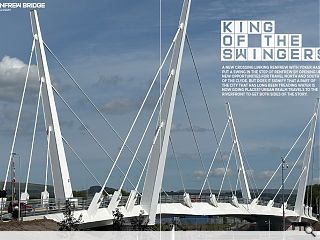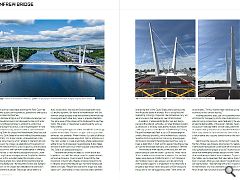Renfrew Bridge: King of the Swingers
4 Aug 2025
A new crossing over the River Clyde has put a swing in the step of Renfrew and Yoker by opening up new opportunities for travel, but does it signify that a part of the city that has long been treading water is now going places? Urban Realm travels to the riverfront to get both sides of the story.
The first opening road bridge spanning the River Clyde has swung into action, carrying vehicles, pedestrians and cyclists between Yoker and Renfrew. The Renfrew Bridge is a £117m infrastructure project led by Renfrewshire Council and delivered by main contractor Graham and Sweco engineers, employing a distinctive twin-leaf design that utilises a cable-stayed system to hold up a two-lane crossing and associated active travel routes. Spanning 184m the bridge links Meadowside Street south of the river to Dock Street in the north without blocking access to ship traffic. The bridge stands just downstream of the previous ferry crossing, which remains in operation for now.
Above all the bridge is a celebration of movement, not just in the motion of traffic across its span but the structural gymnastics which see it perform a daily dance of swinging open and shut to facilitate the passage of ships and Urban Realm caught up with design principal Tony Kettle of Kettle Collective to find out what makes this crossing unique. Standing amidst the crowds thronging the bridge for its opening Kettle said: “Renfrewshire Council was trying to find a form for the bridge that celebrated the connection and movement of people. The bridge can be seen as a static structure but this and the Govan bridge both move, it’s another dynamic. We have an extra dimension with the Renfrew Bridge because it has two elements and when they move against each other they move in opposite directions. You get a sense of the cranes on the Clyde and the way they swing. The angles of these tower supports are the same as those cranes.”
Contrasting the approach taken here with its sister bridge upriver Kettle added: “Govan is a single crane support, here we’ve got four elements. When it moves it’s a play of all those elements hopefully, people enjoy that. There is a theatre to it. The client wanted to create a landmark, where people would gather to see the bridge opening and closing. It also makes the land on both banks much more valuable and productive. The Clyde is an underused resource.” This ballet dance may be beautiful to look at but also impedes access, with the bridge subject to regular closures, some of up to several hours in length, to permit the free movement of river traffic. Majestic motions not permitting it will leave drivers who failed to get the memo nonplussed. Kettle continued: “People who look at the bridge as a static object don’t understand it. It has a dynamic that is different Previous page - Pylons punch the skyline in celebration Above - The geography of the river has been forever changed. Image by Drone Scotland 43 to anything else on the Clyde. Ships used to get launched from these dry docks at an angle, this is taking that and celebrating it strongly. I hope that the old Renfrew Ferry will remain in use so that people can see it from the river.”
A variation of a Bascule Bridge the twin-leaf design swings to the side not vertically, a la Tower Bridge in London, (a concession to the busy skies above). Instead, the modern cable stay system is more akin to the Queensferry Crossing. The joint between each ‘leaf’ sits at a 30-degree angle in a nod to the local dry docks, while inclined masts rotate to resemble the turning motion of cranes. By drawing upon principles of movement the bridge has become a place to linger, a destination in itself, so that people make the journey as much for the bridge itself as to see Braehead or Renfrew. “We looked at other options, some crazy, but with the airport being so close we couldn’t go too far,” notes Kettle. “It has to work from an economic standpoint, the twin-leaf makes sense because it splits the span in half. It makes all the members lesser. It also allowed us to do something with the tower supports to angle them in two directions. A singular bridge would have a long span of 184m and you’d end up with a very tall supporting tower. There were a lot of constraints. The four towers made sense but giving them resonance in this context was key.”
Teething problems aside, part of the pavement remains unfinished for the opening on the West Dunbartonshire side and some compromises were made along the way to ensure the deliverability of the design. Notably marginally reduced 3m walkway widths on both sides, below the 4m recommended by Sustrans for comfortable shared use. Other components of the brief have also been shed, notably a visitor centre and a second control room on the northern bank. Standing at the nexus of a 3d transport jigsaw the Renfrew Bridge tugs Glasgow back toward its neglected riverfront, bringing people closer together in the process. Having worked on the project since 2017 Kettle has come full circle from developing concept designs for the Falkirk Wheel, all while retaining a childish sense of wonder: “If you stand in the middle, you’ve never seen that view before. Even if you’d been on a boat. When you look down through the joins you can see the water. I was standing with a foot on each side!”
All that remains is to find a nickname, suggestions of the Ninja Bridge may not catch on but the Chopsticks might.




